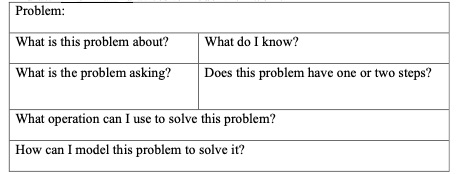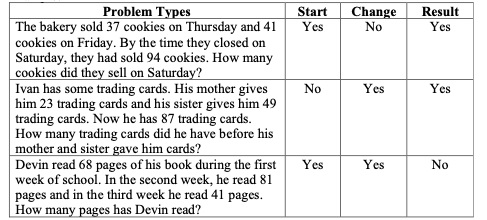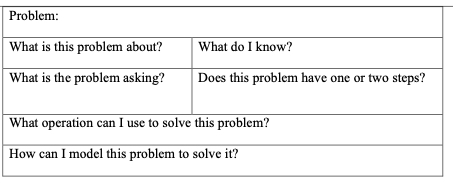General Information
Benchmark Instructional Guide
Connecting Benchmarks/Horizontal Alignment
Terms from the K-12 Glossary
- Associative Property of Addition
- Commutative Property of Addition
- Equation
- Expression
- Number line
Vertical Alignment
Previous Benchmarks
Next Benchmarks
Purpose and Instructional Strategies
The purpose of this benchmark is to provide opportunities for students to solve various real-world situation types involving addition and subtraction. In grade 1, students solved real-world addition and subtraction problems within 20 (MTR.7.1).- Instruction includes experience with all situation types involving addition and subtraction.
- Mastery of all situation types, as shown in Appendix A, is expected at by the end of this grade level.
- Instruction leads students to focus on context and apply reasoning to determine the appropriate operation.
- Instruction includes the use of number lines, drawings, diagrams or models to represent problem context.
Common Misconceptions or Errors
- Students may have difficulty interpreting the quantities in the context of the problem or misidentifying the operation needed to solve the problem.
- Students may interpret a start or change unknown problem as a result unknown problem.
- Students may look for key words which can lead to the wrong operation and cause students to ignore context and reasoning.
Strategies to Support Tiered Instruction
- Teacher provides a graphic organizer to record information about the problem that focuses on the quantities in context and the operation(s) needed to solve the problem.
- For example, use the following problem to complete the organizer below.
- John collected 23 leaves on his walk on Monday. On Tuesday, he collected 35 leaves on his walk. At the end of his walk on Wednesday, he had collected a total of 97 leaves. How many leaves did he collect on Wednesday?
- What is this problem about? John collected leaves on Monday, Tuesday, and Wednesday.
- What do I know? John collected 23 leaves on Monday and 35 leaves on Tuesday. He has a total of 97 leaves.
- What is the problem asking? How many leaves did John collect Wednesday?
- Does this problem have one or two steps? This problem has 2 steps.
- What operation can I use to solve this problem? I can add and subtract.
- How can I model this problem to solve it? Students may use an equation, a drawing, or manipulatives to model their work.

- Teacher provides the chart/organizer below and guides students through determining if the start, change and result are known for each problem.
- Example:

- Instruction provides opportunities to determine the context of numberless word problems with a focus on what is happening in the problem and how to solve it.
- For example, the teacher provides the following word problem to students. Cindy Lou needs ___ cupcakes for the bake sale. She has already made ___ cupcakes. How many cupcakes does she still need to make? Teacher asks: What is this problem about? What is happening in this problem? What information do we know? How do you think you would solve this problem?

Instructional Tasks
Instructional Task 1(MTR.4.1)
A bus leaves Park Elementary School with 27 students. Twelve students get off at stop A and eight more get off at stop B. How many students are on the bus at stop C? [Teacher note: Discussion of student responses should allow the opportunity to make connections between varying strategies and discuss the efficiency of a chosen strategy.]Instructional Task 2
Create a word problem that can be solved using the equation 76=11+65.
Instructional Items
Instructional Item 1
Mr. Gene sharpened some pencils. Ms. Smith sharpened 32 pencils. There are 78 sharpened pencils. How many pencils did Mr. Gene sharpen?Instructional Item 2
Josephine bought 86 tickets at the fair to go on rides. She used 28 tickets for rides. She then gave her sister 11 tickets so she could ride some rides too. How many tickets does Josephine have left?
*The strategies, tasks and items included in the B1G-M are examples and should not be considered comprehensive.
